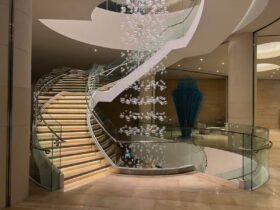For green hilly magic looking out onto the blue waves, head to Sardinia. Contributing editor Kerri Allen explains why.
SARDINIA, Italy — It seems like Sardinia is the It place to go these days. It’s the Reykjavik of 2009. The Lisbon of 2017. The Shannon of 2021. The in-the-know set has moved on from Sicily, which is still recovering from its White Lotus season two hangover.
But Sardinia has been a mainstay of Italian vacations since the 1960s. No mere spit of sandy beach, the island is about the size of Vermont and its regions are varied. Stuck in the Mediterranean between France, Italy, and Tunisia, it has been fiercely fought over for generations, forging proud protection of its culture, food, and coastline.
Costa Smeralda (the Emerald Coast) in the Gallura province on the northeastern corner of the island is a Miami Beach-type seaside town where the well-heeled go to see and be seen. It’s been serving up la dolce vita for decades.
As more tourists arrive on the Costa Smeralda with the goal of venturing farther out, one Sardinian family made it their mission to preserve the region’s heritage and environment while still offering that world-renowned Italian hospitality.


A Lush Sardinian Hideaway
For more than 30 years, the Muntoni family has been building luxury properties in northern Sardinia and now own and operate eight resorts under the Delphina Resorts umbrella.
My husband and I stationed ourselves at their Hotel Capo d’Orso property in the seaside town of Palau. Capo d’Orso is a lovers’ hideaway. (The name — “bear’s head” — is an homage to a unique rock formation in town.) Footpaths throughout the resort wend along overgrown foliage, such that every pair of loungers or floating dock feels like a find you and your partner were the first to discover.
Though built in the 1980s, there’s nothing outdated or even kitschy-throwback about the place. It’s all green hilly magic, looking out onto the blue waves. During our stay, a harpist played every day (lovely and not even a little cheesy) and fresh meals were available around so many of those hidden corners. A particular vignette to remember: luxuriating over lunch on one of the many floating docks, Campari in hand, serenity in the air.
Indeed, at Capo d’Orso, the drinks are free-flowing. As you arrive at what feels like a secret Italian garden, you are offered a prosecco or a spritz. After an afternoon of swimming or boating, your evening aperitivo awaits you.


I fell in madly love with vermentino di Gallura, the island’s only DOCG wine. It’s not quite the same as mainland Italian or even specifically Sardinian vermentino. This varietal of white wine springs from Gallura’s thin granitic soils, which give each glass lively minerality with warm and delicate hints of citrus. I could not get enough of it. (I don’t know the ABV, but I never felt drunk. Just light.) One night, we brought a particularly nice bottle back to our room. (Actually, you can too, courtesy of the meticulously curated Delphina Resorts online shop.) We listened to the strains of an acoustic guitar ascend to our balcony as the sun set over the Mediterranean.
Traditional wine needs traditional food, and the main restaurant Il Paguro serves up divine culurgiones, a durum-wheat ravioli stuffed with whipped potato, pecorino cheese, ricotta, and spearmint. Little pillows of silly deliciousness.
The standout meal was off-property at Ristorante da Thomas. Opened in 1978, this family-run restaurant has perfected many Sardinian dishes, particularly fregola sarda, a pasta similar to Israeli couscous made from durum wheat flour served with clams, prawns, and saffron oil.
Rustic and Rugged
A curving twelve miles north of Palau is another Muntoni hotel, La Licchola, which is part of the larger Valle dell’Erica resort. Built in 2013, the 125-room property-within-a-property elevates ancient Sardinian craftsmanship with a contemporary touch.
In the common areas are sturdy and intricate wooden desks, shelves, and benches. Floors are made of marble from the town of Orosei. Guest rooms are detailed with vibrant painted tiles. Hand-woven fabrics from the inland village of Aggisu make for brilliant bedding and backboards. Rush-palm baskets from Castelsardo and Etruscan terracotta ceramics make it all feel homey. Every element pays tribute to the island’s history of rugged living and rooted culture.
Unlike Capo d’Orso’s all-encompassing greenery, La Licciola’s grounds are wide and sprawling, almost flat, and glide into the coastline. The walkways are lined with fragrant rosemary bushes, olive trees, heather, and myrtle.





The resort’s open-air restaurant Il Grecale is where we discovered exactly what myrtle can do. It can become mirto. Considered the official spirit of Sardinia, the potent liquid of deep purple is a charming, herbal after-dinner drink, almost like a more elegant version of Jägermeister.
Guests who want to take a taste of Sardinia home can shop for their own bottles of mirto, vermentino, and other non-boozy items not only online, but also at the property’s sweet little recreation of a local town square.
Overtourism being what it is, Sardinia could become the next Positano or Venice or even Rome, but the Muntoni family, who have lived on and loved this land for generations, is poised to protect it.
Here’s hoping that under their careful and thoughtful stewardship, the northern tip of this special land may be able to preserve its rich heritage and authentic charm for many, many years to come.








Leave a Reply